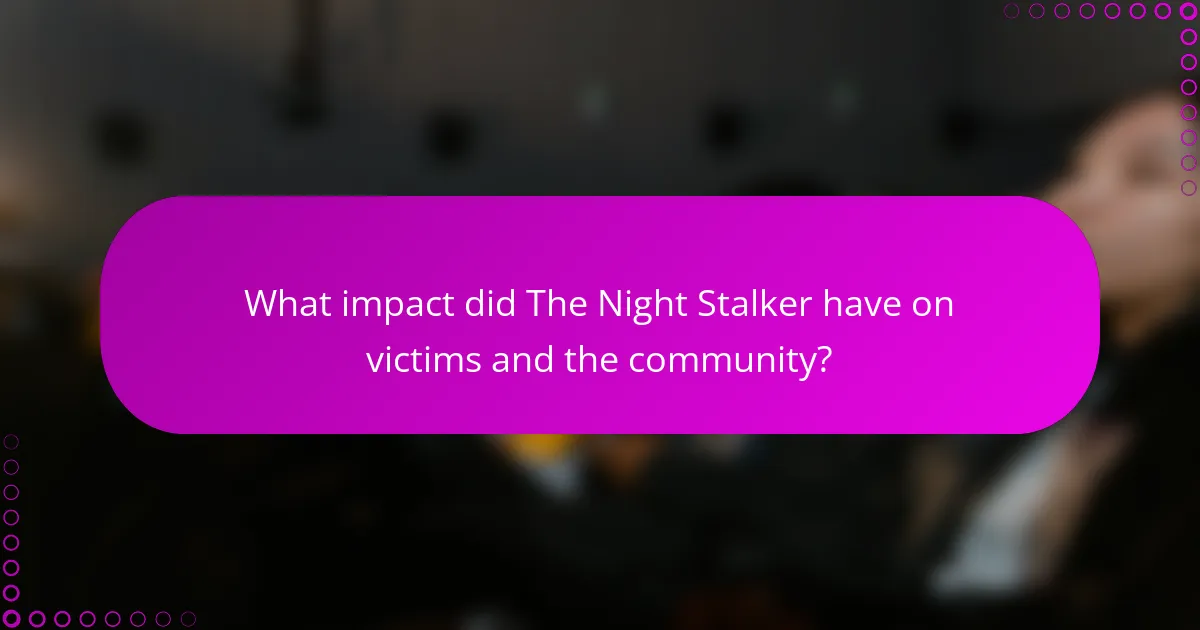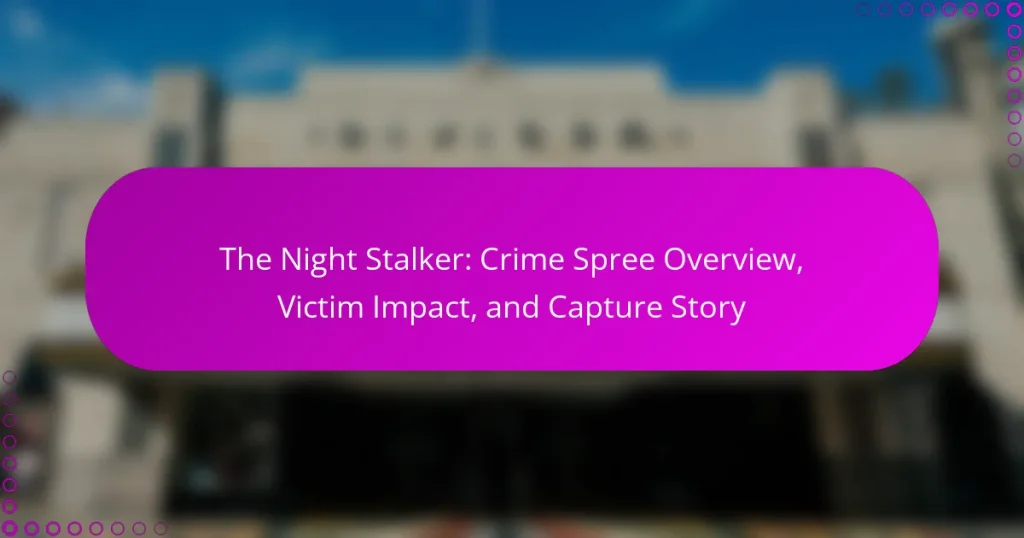Richard Ramirez, known as The Night Stalker, was an American serial killer active in California during the mid-1980s. He committed numerous home invasion murders, assaults, and burglaries, causing widespread fear in the Los Angeles and San Francisco areas. The article outlines the brutal nature of his crimes, the psychological impact on victims and the community, and details of his capture on August 31, 1985, by vigilant residents. It also covers the subsequent trial and conviction of Ramirez, who was sentenced to death in 1989 and died in prison in 2013.

What is The Night Stalker?
The Night Stalker is the nickname given to Richard Ramirez, an American serial killer. He was active in California during the mid-1980s. Ramirez committed a series of home invasion murders, [censured] assaults, and burglaries. His crimes instilled fear across the Los Angeles and San Francisco areas. The Night Stalker was known for his brutal methods and varied victim profiles. He was ultimately captured in 1985 after a lengthy manhunt. His trial began in 1988, and he was convicted on multiple counts of murder and [censured] assault. Ramirez was sentenced to death but died in prison in 2013.
How did The Night Stalker become infamous?
The Night Stalker became infamous due to a series of brutal crimes in California during the mid-1980s. He was responsible for at least 13 murders, numerous [censured] assaults, and home invasions. His modus operandi involved breaking into homes at night and attacking victims, often using a variety of weapons. The media extensively covered his crimes, which heightened public fear and fascination. His ability to evade capture for months added to his notoriety. The police linked the crimes through forensic evidence, leading to a massive manhunt. He was eventually apprehended in 1985, after a public tip-off. His trial drew significant media attention, cementing his status as a notorious criminal.
What were the key events during The Night Stalker’s crime spree?
The key events during The Night Stalker’s crime spree include a series of brutal attacks in California from 1984 to 1985. Richard Ramirez, known as The Night Stalker, committed home invasions, [censured] assaults, and murders. His first confirmed murder occurred on June 28, 1984. He targeted victims indiscriminately, often using a variety of weapons. The attacks created widespread fear across the state. Law enforcement struggled to connect the crimes initially. A turning point came in August 1985 when a composite sketch was released. Public awareness increased, leading to tips that helped identify Ramirez. He was ultimately captured on August 30, 1985, after being recognized by citizens. His crime spree left a lasting impact on the communities affected.
What methods did The Night Stalker use in his attacks?
The Night Stalker used a variety of methods in his attacks. He primarily targeted victims during the night. Breaking into homes was a common tactic. He often used a weapon, such as a firearm or a knife. Strangulation was another method he employed. Many victims were sexually assaulted. He also used fear and psychological manipulation. His methods contributed to widespread panic in the communities he targeted. The combination of these tactics made him particularly notorious.
What is the timeline of The Night Stalker’s criminal activities?
The Night Stalker’s criminal activities occurred primarily between April 1984 and August 1985. In April 1984, Richard Ramirez committed his first known murder in the Los Angeles area. He continued his spree, targeting victims in various locations, including Los Angeles and San Francisco. By May 1985, Ramirez had escalated his crimes, committing multiple home invasions, [censured] assaults, and murders. His modus operandi involved breaking into homes at night and attacking residents. In August 1985, public awareness of his crimes peaked, leading to increased media coverage. Ramirez was finally captured on August 31, 1985, after being recognized by citizens in Los Angeles. His trial began in 1988, where he was convicted of 13 counts of murder.
What were the significant dates and locations involved?
The significant dates and locations involved in the Night Stalker case include several key events. The crime spree began in 1984, with the first known attack occurring on April 10 in Los Angeles, California. Over the following months, multiple assaults took place across Southern California, including in cities like San Francisco and Orange County. The Night Stalker’s capture occurred on August 31, 1985, in Los Angeles. The trial began in 1986, leading to his conviction in 1989. These dates and locations highlight the extensive impact of the Night Stalker’s actions across the region.
How did the public and law enforcement respond during this period?
The public and law enforcement responded with heightened fear and urgency during this period. Residents in affected areas increased security measures, such as locking doors and installing alarms. Many people reported suspicious activity to the police, hoping to aid in the investigation. Law enforcement launched extensive manhunts and increased patrols in neighborhoods. They also held community meetings to inform the public about safety precautions. The media played a significant role by broadcasting information about the suspect, leading to numerous tips. Ultimately, public vigilance and police collaboration were crucial in capturing the Night Stalker.
What were the psychological factors behind The Night Stalker’s actions?
The Night Stalker’s actions were influenced by several psychological factors. He exhibited traits of antisocial personality disorder. This disorder is characterized by a lack of empathy and remorse. Additionally, he displayed narcissistic tendencies, seeking power and control over his victims. His childhood experiences included trauma and exposure to violence. These factors may have contributed to his violent behavior later in life. Research indicates a correlation between early trauma and later criminal behavior. The combination of these psychological traits created a predisposition for his heinous actions.
How did The Night Stalker’s background influence his behavior?
The Night Stalker’s background significantly influenced his behavior through early exposure to violence and trauma. Richard Ramirez experienced a troubled childhood marked by abuse and neglect. His cousin, a Vietnam War veteran, introduced him to violent imagery and criminal behavior. This exposure desensitized him to violence and shaped his worldview. Additionally, his family’s unstable environment contributed to his later criminal actions. Psychological studies indicate that such backgrounds can lead to antisocial behavior in adulthood. Ramirez’s criminal activities reflected a culmination of these early experiences. His history of drug use further exacerbated his violent tendencies. These factors combined created a profile of a serial killer driven by deep-seated issues stemming from his upbringing.
What patterns can be identified in his choice of victims?
It is observed that the Night Stalker primarily targeted vulnerable individuals. His victims were often women and elderly people. Many victims were attacked in their homes during the night. The attacker showed a preference for locations in California, particularly in urban areas. He frequently chose victims who lived alone. Additionally, he exhibited a pattern of using weapons, including firearms and knives. The randomness of his attacks suggests a lack of specific victimology. This pattern of targeting the defenseless contributed to widespread fear in the community.

What impact did The Night Stalker have on victims and the community?
The Night Stalker had a profound impact on victims and the community. Victims experienced severe trauma, fear, and loss. Many suffered physical and emotional scars from the attacks. The community faced heightened anxiety and paranoia. Residents altered their daily routines to enhance safety. Reports indicated a spike in home security system sales during this period. Law enforcement agencies increased patrols and community outreach efforts. The media coverage intensified public awareness of crime and safety issues. Overall, The Night Stalker’s actions left lasting psychological effects on individuals and the community.
How did The Night Stalker’s crimes affect the victims’ families?
The Night Stalker’s crimes had devastating effects on the victims’ families. Families experienced profound grief and loss due to the murders. Many victims’ relatives reported long-term emotional trauma. The fear and anxiety in their communities heightened significantly. Survivors faced challenges in coping with the violent nature of the crimes. Support groups and counseling became essential for many affected families. The case received extensive media coverage, which added to their distress. Overall, the impact on victims’ families was deep and lasting.
What are some personal stories of the victims and their experiences?
It is not possible to provide specific personal stories of the victims and their experiences related to “The Night Stalker.” The details of individual victim experiences are often sensitive and may not be publicly documented in a way that allows for a factual recounting.
How did the crimes alter the lives of survivors?
The crimes committed by the Night Stalker significantly altered the lives of survivors. Many survivors experienced long-term psychological trauma, including PTSD. Survivors reported heightened anxiety and fear in their daily lives. Some faced challenges in forming relationships due to trust issues. The crimes disrupted their sense of safety and security in their homes. Numerous survivors required therapy and support to cope with their experiences. Financial burdens arose from medical expenses and lost wages. Overall, the impact of the crimes was profound and lasting for those affected.
What was the broader societal impact of The Night Stalker’s spree?
The broader societal impact of The Night Stalker’s spree was significant. It instilled widespread fear across California during the mid-1980s. The crimes led to heightened public awareness of serial killers. Communities became more vigilant and cautious about safety. Law enforcement agencies improved communication and collaboration. Media coverage intensified scrutiny on crime reporting and victim advocacy. The case influenced popular culture, inspiring numerous films and documentaries. Overall, the spree had lasting effects on crime prevention strategies and societal perceptions of safety.
How did the crime spree influence public perception of safety?
The crime spree significantly heightened public anxiety regarding safety. Residents in affected areas felt increasingly vulnerable. Reports of brutal attacks spread fear among communities. Media coverage amplified the perception of danger. Many individuals altered their daily routines to enhance personal security. Increased demand for home security systems was observed. Local law enforcement faced pressure to improve safety measures. This collective fear reshaped public discussions about crime and community safety.
What changes in law enforcement practices were implemented as a result?
Law enforcement practices changed significantly following the Night Stalker case. The introduction of a centralized database for tracking serial crimes became a priority. This allowed agencies to share information more effectively. Increased emphasis on forensic evidence collection was implemented. Law enforcement also adopted new strategies for public engagement during investigations. Enhanced training programs for officers on serial crime patterns were established. The case led to improved collaboration between local and federal agencies. These changes aimed to prevent similar incidents in the future and enhance overall public safety.
What psychological effects did The Night Stalker’s crimes have on the community?
The Night Stalker’s crimes caused significant psychological effects on the community. Residents experienced heightened fear and anxiety. Many felt unsafe in their own homes. The crimes led to increased vigilance and paranoia among individuals. Community gatherings and outdoor activities decreased due to fear of potential attacks. Psychological distress manifested in increased reports of insomnia and anxiety disorders. Local law enforcement received an influx of calls regarding suspicious activity. Public trust in safety measures diminished during the crime spree. These effects were documented in various psychological studies examining community trauma in response to violent crime.
How did fear and anxiety manifest in the affected neighborhoods?
Fear and anxiety manifested in the affected neighborhoods through heightened vigilance and community distress. Residents reported increased paranoia, often avoiding nighttime activities. Many individuals installed security systems and reinforced home security measures. Reports of insomnia and anxiety-related health issues rose significantly during the crime spree. Community gatherings focused on safety discussions and sharing experiences became common. Local law enforcement increased patrols, but residents still felt unsafe. The pervasive fear altered daily routines and social interactions within these neighborhoods. Overall, the psychological impact was profound, leading to long-term community trauma.
What long-term effects did this crime spree have on community trust?
The crime spree significantly eroded community trust. Residents felt unsafe and vulnerable after the events. Fear became prevalent, leading to social isolation. Many community members avoided public spaces. Trust in local law enforcement declined due to perceived inadequacies in protection. Reports indicated increased skepticism towards police effectiveness. Community cohesion weakened as neighbors became suspicious of each other. Long-term recovery of trust required extensive community engagement and support initiatives.

How was The Night Stalker captured?
The Night Stalker, also known as Richard Ramirez, was captured on August 31, 1985. A group of residents in East Los Angeles apprehended him after recognizing his face from a newspaper. They chased him down and restrained him until police arrived. The police arrested him, marking the end of his crime spree. His capture followed a series of brutal attacks across California, instilling fear in the community. The residents played a crucial role in his arrest by acting on their awareness of his identity. This grassroots effort led to his eventual conviction for multiple murders and assaults. Ramirez was sentenced to death in 1989.
What were the key factors that led to The Night Stalker’s arrest?
The key factors that led to The Night Stalker’s arrest included forensic evidence, eyewitness accounts, and a distinctive shoe print. Forensic evidence linked him to multiple crime scenes. DNA collected from victims played a crucial role in identifying him. Eyewitness accounts provided descriptions that matched his appearance. A shoe print from a crime scene was traced to a specific brand and size. This shoe print ultimately connected him to the crimes. Additionally, the public’s assistance through media coverage helped law enforcement locate him. These combined factors led to his capture in 1985.
What role did forensic evidence play in the investigation?
Forensic evidence played a crucial role in the investigation of the Night Stalker. It helped link Richard Ramirez to multiple crime scenes. Key forensic findings included fingerprints and shoeprints found at various locations. These pieces of evidence provided law enforcement with critical leads. DNA analysis also confirmed his presence at certain crime scenes. The forensic evidence ultimately contributed to his identification and capture. This evidence was pivotal in building a strong case against him.
How did public tips contribute to the capture of The Night Stalker?
Public tips played a crucial role in the capture of The Night Stalker, also known as Richard Ramirez. After a series of brutal crimes in California, law enforcement released a sketch of the suspect. This sketch prompted numerous calls from the public, providing vital leads. A significant breakthrough occurred when a tipster recognized Ramirez from the sketch and reported him to the police. Additionally, the public’s awareness helped increase vigilance in neighborhoods, leading to more sightings. Ultimately, these tips culminated in Ramirez’s arrest on August 31, 1985. The collaboration between law enforcement and the community was essential in bringing him to justice.
What was the law enforcement strategy used to apprehend The Night Stalker?
The law enforcement strategy used to apprehend The Night Stalker involved a combination of public awareness campaigns and forensic evidence collection. Authorities distributed sketches of the suspect to the media, urging the public to report any sightings. This strategy aimed to generate tips and leads from the community. Additionally, investigators utilized DNA evidence from crime scenes to link the suspect to multiple attacks. The strategy also included surveillance and stakeouts based on tips received. Ultimately, the combination of community involvement and forensic science led to the capture of Richard Ramirez in 1985. His arrest was made possible by a vigilant public and the effective use of investigative techniques.
How did collaboration between different agencies aid in the capture?
Collaboration between different agencies was crucial in the capture of the Night Stalker. The LAPD and the San Francisco Police Department shared information about the suspect’s MO. This cooperation helped establish a clearer profile of the criminal. Additionally, the FBI provided resources and expertise in behavioral analysis. The combined efforts led to a more effective manhunt. Public tips were also gathered through joint outreach initiatives. These strategies increased the chances of locating the suspect. Ultimately, the collaboration resulted in the successful capture of Richard Ramirez in 1985.
What challenges did law enforcement face during the investigation?
Law enforcement faced significant challenges during the investigation of the Night Stalker. One major challenge was the lack of physical evidence at crime scenes. Many of the attacks occurred in the victims’ homes, leaving little trace for detectives to follow. Additionally, the suspect used various methods to gain entry, complicating the investigation.
Another challenge was the absence of a clear pattern in the crimes. The Night Stalker targeted diverse locations and victims, making it difficult to establish a profile. This led to confusion among law enforcement agencies. Communication barriers between different jurisdictions also hampered the investigation.
Furthermore, the media coverage created public pressure for quick results. This pressure sometimes led to rushed decisions that did not yield beneficial outcomes. The psychological impact on victims and their families added another layer of complexity, as officers had to navigate sensitive interactions.
Overall, these challenges significantly hindered the effectiveness and speed of the investigation into the Night Stalker.
What were the legal proceedings following The Night Stalker’s capture?
Following The Night Stalker’s capture, legal proceedings began promptly. Richard Ramirez faced multiple charges, including murder, [censured] assault, and burglary. His trial started in 1988 and lasted for over four years. The proceedings were highly publicized, attracting significant media attention. In 1996, Ramirez was convicted on 13 counts of murder and 30 other felonies. He received a death sentence, which was upheld by the California Supreme Court. Ramirez remained on death row until his death in 2013.
What charges were brought against The Night Stalker?
The Night Stalker, also known as Richard Ramirez, faced multiple charges including 13 counts of murder. He was charged with 5 counts of attempted murder and 11 counts of [censured] assault. Additionally, he faced 14 counts of burglary. The charges stemmed from a series of brutal crimes committed in California between 1984 and 1985. His trial revealed the extensive nature of his violent acts, which included home invasions and attacks on both men and women. The evidence presented during the trial confirmed his guilt in these heinous offenses.
How did the trial unfold and what was the public reaction?
The trial of Richard Ramirez, known as the Night Stalker, began in July 1988. It lasted for over four months, concluding in September 1989. During the trial, numerous witnesses testified about his brutal crimes. The prosecution presented compelling evidence, including DNA and fingerprint matches. Ramirez exhibited erratic behavior in court, often smiling at the jury. The public closely followed the trial, with significant media coverage. Many were outraged by the heinous nature of his crimes. The trial garnered intense public interest, leading to packed courtrooms. Ultimately, Ramirez was convicted on 13 counts of murder and multiple counts of [censured] assault. The verdict elicited relief and satisfaction from the public and victims’ families.
What lessons can be learned from The Night Stalker’s case?
The Night Stalker’s case teaches several important lessons about crime prevention and investigation. Firstly, it highlights the significance of community awareness and vigilance. Residents in affected areas reported suspicious activities, which aided law enforcement. Secondly, the case underscores the importance of timely information sharing among agencies. The collaboration between local police and federal authorities was crucial in capturing Richard Ramirez. Thirdly, it illustrates the psychological impact of crime on victims and communities. Many survivors experienced lasting trauma, emphasizing the need for support systems. Lastly, the case demonstrates the effectiveness of forensic science in solving crimes. DNA evidence played a pivotal role in linking Ramirez to multiple crime scenes. These lessons can guide future crime prevention strategies and victim support initiatives.
How can communities better prepare for similar threats in the future?
Communities can better prepare for similar threats by enhancing public awareness and education about safety measures. Implementing regular safety workshops can inform residents about crime prevention strategies. Establishing neighborhood watch programs fosters community vigilance and cooperation. Increasing police presence in high-risk areas can deter potential criminals. Utilizing technology, such as surveillance cameras, can improve monitoring and response times. Creating emergency response plans ensures swift action during threats. Engaging with local organizations can strengthen community ties and resources. Research shows that proactive community involvement reduces crime rates significantly, as evidenced by studies from the National Institute of Justice.
What strategies can law enforcement adopt to improve public safety?
Law enforcement can adopt community policing strategies to improve public safety. This approach fosters partnerships between police and community members. It encourages proactive problem-solving for crime-related issues. Regular community meetings can enhance communication and trust. Officers can engage in neighborhood patrols to build relationships. Data-driven policing can identify crime hotspots for focused interventions. Training in de-escalation techniques can reduce confrontations. Implementing mental health crisis intervention teams can address underlying issues effectively. These strategies have shown to reduce crime rates and improve community relations.
The Night Stalker refers to Richard Ramirez, an infamous American serial killer active in California during the mid-1980s. His crime spree included at least 13 murders, numerous [censured] assaults, and home invasions, instilling widespread fear in communities. The article outlines key events during his criminal activities, methods of operation, and the psychological impact on victims and the community. It also details the investigation leading to his capture in 1985, the subsequent legal proceedings, and the long-term effects on survivors and their families. Finally, the article highlights lessons learned from the case and strategies for improving public safety and community preparedness.


